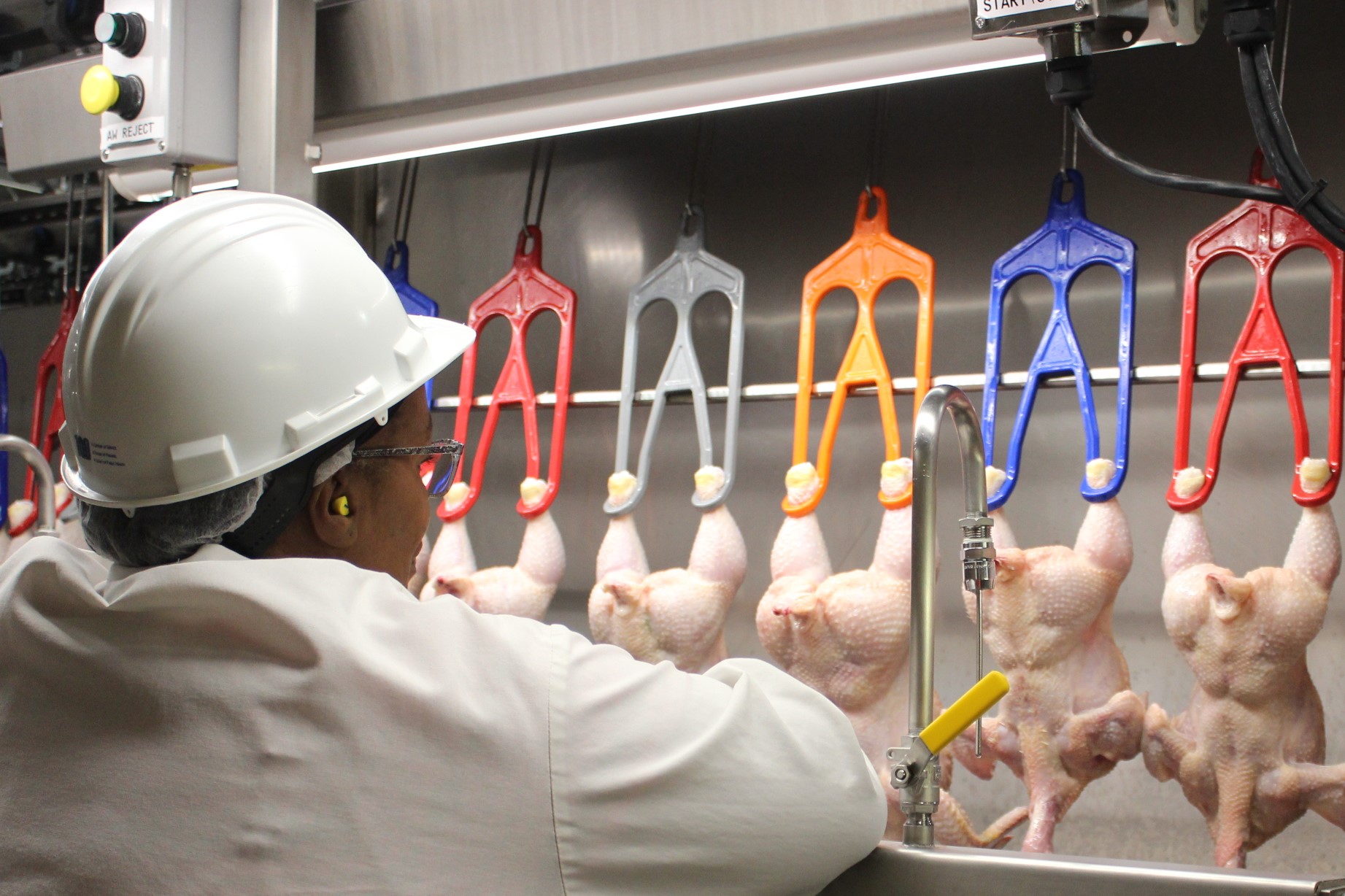
Equivalence
Determining equivalence of a country’s food safety inspection system is essential for protecting public health.
What is Equivalence?
Equivalence is the process by which the Food Safety and Inspection Service (FSIS) determines whether a country's food safety inspection system achieves an appropriate level of public health protection as applied domestically by FSIS in the United States (U.S.). Additionally, the foreign food safety inspection system is to provide standards equivalent to that of the FSIS to ensure other non-food safety requirements (such as humane handling, accurate labeling, and assurance that meat, poultry, or egg products are not economically adulterated) are met. The country is not required to develop and implement the same regulations or inspection procedures as FSIS, but rather the country must objectively demonstrate how its laws, regulations and procedures meet an equivalent level of public health protection to FSIS' inspection system. Countries wishing to become eligible to export meat, poultry, or egg products to the United States must demonstrate that they have a regulatory food safety inspection system that is equivalent to that of FSIS.
Equivalence Background
Determining equivalence of a country's food safety inspection system is essential for protecting public health. An equivalence determination of an exporting country's regulatory food safety inspection system for meat, poultry, or egg products is a prerequisite to import these products into the United States. FSIS is the U.S. Central Competent Authority (CCA) responsible for regulating and inspecting meat, poultry, and egg products. FSIS implements a process to make an equivalence determination to ensure that U.S. treaty obligations under the World Trade Organization's (WTO) Agreement on the Application of Sanitary and Phytosanitary Measures (SPS Agreement) are met. The SPS Agreement sets out the basic international rules for food safety and animal and plant health standards.
To ensure that meat, poultry, or egg products are safe, wholesome, unadulterated, and properly labeled and packaged, FSIS implements the Federal Meat Inspection Act (FMIA), Poultry Products Inspection Act (PPIA), Egg Products Inspection Act (EPIA), Humane Methods of Slaughter Act (HMSA), and regulations under Title 9 Code of Federal Regulations (CFR) Parts 300-590. FSIS ensures that a country's food safety inspection system addresses U.S. food safety regulatory-based objectives as set forth in the FMIA, PPIA, and EPIA. Food safety regulatory-based objectives are food safety goals for preventing the occurrence of an identified food safety hazard.
The criteria by which FSIS assesses the equivalence of a country's food safety inspection system can be found under Title 9 CFR 327.2 (for meat products), 557.2 (for Siluriformes fish and fish products), 381.196 (for poultry products), and 590.910 (for egg products).
Types of Equivalence Determinations
There are four types of equivalence determinations: (1) initial equivalence, (2) ongoing equivalence verification, (3) reinstatement of equivalence, and (4) individual sanitary measure (ISM) equivalence.
| Types of Equivalence Determinations | Explanation About the Type of Equivalence Determination |
|---|---|
| (1) Initial equivalence |
|
| (2) Ongoing equivalence verification |
|
| (3) Reinstatement of equivalence |
|
| (4) Individual sanitary measure |
|
The Equivalence Process
The following sections on initial equivalence, ongoing equivalence verification, reinstatement of equivalence and individual sanitary measures describe FSIS' process for making an equivalence determination.
The following six process steps briefly outline how an initial equivalence determination is made for a country wishing to export meat, poultry, or egg products to the United States for the first time:
- Country submits a formal written request for initial equivalence to FSIS. The formal request can be submitted to FSIS' Office of International Coordination (OIC) at InternationalCoordination@usda.gov.
- Country submits responses and supporting documentation to address food safety objectives in the Self-Reporting Tool (SRT)
- FSIS reviews SRT responses and supporting documentation
- FSIS conducts onsite verification audit(s)
- FSIS issues public notification proposing to list a foreign country as eligible to export products to the United States in the Federal Register
- FSIS considers public comments and other information and, if appropriate, issues a final determination of equivalence in the Federal Register; FSIS also responds to comments in that Federal Register notice.
The SRT is a questionnaire that provides an organized means for the country's government to demonstrate that its inspection system achieves an equivalent level of protection as applied domestically by FSIS in the United States.
The SRT is arranged into six components:
- Government Oversight (e.g., Organization and Administration, Enforcement Authority, Government Inspection Personnel-Training/Staffing)
- Government Verification of Food Safety and Other Consumer Protection Requirements (e.g., Humane Handling, Ante-mortem Inspection, Post-mortem Inspection, Product Standards and Labeling)
- Government Sanitation Verification
- Government Hazard Analysis and Critical Control Point (HACCP) System Verification
- Government Chemical Residue Program
- Government Microbiological Pathogen and Process Control Programs
For more information on the SRT and initial equivalence process, please refer to the "Additional Resources" section of this web page.
Ongoing Equivalence Verification
FSIS continuously evaluates and verifies the equivalence of an exporting country's food safety inspection system through a three-part process that includes: (1) document reviews, (2) verification audits, and (3) point-of-entry reinspection of meat, poultry, and egg products.
Part 1- Document Reviews
Countries are to submit the following for review at least annually by May 18th:
- Either (1) updated SRT responses, or (2) confirmation to FSIS that the country's CCA has verified its previously submitted SRT responses and supporting documentation are accurate and complete;
- An up-to-date list of all certified establishments eligible to export meat, poultry, or egg products the United States;
- An updated official government chemical residue sampling and testing program, including the previous year's test results; and
- An updated official government microbiological sampling and testing program, including the previous year's test results for the following: (A) Salmonella and Campylobacter in raw meat and poultry products; (B) Listeria monocytogenes (Lm) and Salmonella in ready-to-eat (RTE) meat, poultry, and egg products; (C) food contact surfaces for Lm in certified establishments that produce post-lethality exposed RTE meat and poultry products; and (D) Shiga toxin-producing Escherichia coli (STEC) in raw beef products.
Part 2 - Verification Audits
FSIS periodically conducts a verification audit of every eligible country's food safety inspection system to verify whether the country continues to maintain an equivalent inspection system.
Part 3 - Point-of-Entry Reinspection
All imported shipments of meat, poultry, and egg products that enter the United States are presented to FSIS for reinspection. FSIS checks every imported shipment for eligibility, certification, transportation damage, and labeling. The purpose of point-of-entry reinspection is to monitor the effectiveness of an eligible exporting country's food safety inspection system, not to assess the performance of an individual certified establishment.
For more information about ongoing equivalence verification, please refer to the "Additional Resources" section of this web page.
Reinstatement of Equivalence
The following five process steps briefly outline how a reinstatement of equivalence determination is made when a country wants to start exporting meat, poultry, or egg products again to the United States.
- Country submits a formal written request for reinstatement of a prior equivalence determination to FSIS. The formal request can be submitted to FSIS' OIC at InternationalCoordination@usda.gov.
- Country submits responses and supporting documentation to address food safety objectives in the SRT
- FSIS reviews SRT responses and documentation
- FSIS may conduct onsite verification audit(s)
- FSIS notifies the country of the equivalence determination through official correspondence
NOTE: FSIS does not publish reinstatement of equivalence determinations in the Federal Register because equivalence for the food safety inspection system in the country has already been published.
For more information on reinstatement of equivalence, please refer to the "Additional Resources" section of this web page.
Individual Sanitary Measure
Eligible countries currently exporting meat, poultry, or egg products to the United States request an individual sanitary measure (ISM) when they want to change a procedure in their food safety inspection system. There are typically two reasons an eligible country may request an ISM equivalence determination:
- The country wants to make a change to a procedure in its food safety inspection system that FSIS previously determined was equivalent.
- FSIS has updated its U.S. domestic food safety procedures or requirements and identified that the procedures or requirements affect previous equivalence determinations for specific eligible countries.
The following four process steps briefly outline how an ISM equivalence determination is made:
- Country submits a formal written request for an ISM to FSIS. The format request can be submitted to FSIS' OIC at InternationalCoordination@usda.gov.
- Country submits updated responses and supporting documentation for the ISM through the SRT
- FSIS reviews the updated SRT responses and supporting documentation
- FSIS notifies the country of the ISM equivalence determination through official correspondence
For more information on individual sanitary measures, please refer to the "Additional Resources" section on this web page. Additionally, FSIS maintains a list of countries with significant, non-routine, finalized individual sanitary measures.
-
Self-Reporting Tool
Contains questions regarding regulatory-focused food safety objectives that reflect the equivalence criteria used by FSIS to determine whether a country’s documented food safety inspection system is equivalent to the FSIS inspection system. -
FSIS Product Categorization (Import)
Provides information about the listing of process categories on FSIS official foreign inspection certificates. It applies to official import inspection establishments and actions they may take to meet regulatory requirements for the identification of meat, poultry, and egg products certified for export to the United States. It relates to 9 CFR Part 327 and 9 CFR 417.2(b). -
FSIS Guidance for a Suggested Reporting Table for the Certified Establishment List
-
FSIS Guidance for Foreign Countries: Summary of FSIS’ Official Government Chemical Residue Sampling Program
Provides a summary of FSIS’ official government chemical residue sampling program. -
Summary of FSIS Government Microbiological Sampling Programs Frequencies
Provides a summary of the sampling frequency of FSIS government microbiological testing, including a link to the current FSIS Annual Sampling Plan. -
FSIS Responses to the SRT
Provides a model with FSIS’ responses to the SRT that illustrates the level of detail FSIS needs in foreign country SRT responses to determine whether a country’s food safety inspection system achieves an equivalent level of sanitary protection. -
Importing Products
FSIS is responsible for assuring that U.S. imported meat, poultry and egg products are safe, wholesome, unadulterated, and properly labeled and packaged. -
Inspection of Siluriformes (Imports)
Provides information specific to the imports of Siluriformes fish and fish products. -
Laboratory Guidebooks and Methods
These guidebooks contain current protocols for analytical tests required by FSIS for U.S. domestic regulatory activities on meat, poultry and egg products. They include the FSIS Microbiology Laboratory Guidebook, the FSIS Analytical Chemistry Laboratory Guidebook, and the FSIS Pathology Laboratory Guidebook.
All communications concerning FSIS equivalence should be directed to the Office of International Coordination (OIC) at the contact information below. Communication must come from the country’s Central Competent Authority (CCA).
Please address correspondence to:
United States Department of Agriculture
Food Safety and Inspection Service
Office of International Coordination
1400 Independence Avenue, SW
Room 3143, South Building
Washington, DC 20250
Phone: (202) 708-9543
Fax: (202) 690-3856
E-mail: InternationalCoordination@usda.gov



